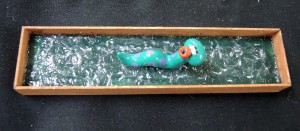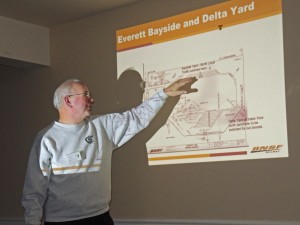Rich Thom / Photos by Rich
The Skagit Valley & Whidbey NMRA Clinic’s meeting on November 11th was attended by 22 regulars and two guests. Guests were Dave Johnson, an Oak Harbor resident and long-time friend of regular Alan Murray, and the evening’s clinician Bob Stafford. In opening remarks, Clinic Chair Rich Blake observed that it was Veteran’s Day and asked: “How many attendees had served?” Many hands went up, to applause and thanks from everyone. Susan Gonzales reported that the October 24th special shop tour and train ride at the Northwest Railway Museum had been enjoyed by 12 clinic members, family and friends (click here to see the previous Grab Iron article). Susan was thanked for making the tour possible, and added that it might be repeated next year. Rich mentioned that a work day is a possibility, too – there’s always plenty of work for volunteers at the NWRM. Finally, longtime clinic participant and modeler Curt Johnson let it slip out that November 11th, meeting night, was his birthday. Accordingly Susan presented Curt a cake, but it was only an inedible, 1:1 scale model of one – a hat, which of course Curt had to don. Moral for SV & W clinic members: don’t reveal your birthday.
Jack Tingstad reminded everyone of this season’s model contest in which flatcars with loads will be judged, at the February meeting, as described in last month’s Grab Iron SV & W clinic report. To spur everyone on to enter (and start building before January), Jack brought a work-in-progress car to display (Figure 1). While on a tour of Scotland, Jack found in a Loch Ness gift shop a pencil with the lake’s famous denizen on the top, trimmed Nessie off and made it (her?) the “load” for his car. He added water using Plaid brand Gallery Glass, ripples with Woodland Scenics Water Effects, and dry-brushed white for highlights. There are four contest categories and we suspect that Jack is building this car for the Novelty category — but one man’s novelty can be another’s faithful prototype.
The evening’s clinic presentation, by Bob Stafford, was The BNSF Railway’s Bellingham Sub Operations. Bob (currently the Communications Chair for the 4th Division) spent a 40-year career in the railroad industry, beginning on the Erie Lackawanna. He headed west in 1978, eventually working in seven western states and British Columbia. From 1997 through 2010, when he retired, Bob worked for the BNSF Railway; in 2008-2009 he was Trainmaster of the Bellingham Subdivision — the subject of his talk.
Bob described the physical plant — Everett Bayside and Delta Yard (Fig 2) and the yards in Burlington, Bellingham, and Sumas — and the trains he was responsible for. These included the so-called Haulers: Thornwood Turn (Bayside-Burlington); Train 627 (Custer/Bellingham-Delta); and 644 (Bayside-Sumas). As expected, getting the Haulers over the road was never dull. Bob told several anecdotes, including one about a bad day in January 2009 when the tracks at Stanwood were flooded, and the last train through Stanwood (644 the Sumas Hauler) was hit by a mud slide. The dike there had been sandbagged but urgently needed more, but calls to the local emergency center weren’t answered (crews had their hands full everywhere). In time a City Councilman turned up at the dike, who called the mayor to request some help. Twenty minutes later a truck of sandbags and two school vans arrived, carrying members of the high school football team. They succeeded in building the dike higher, just in time as the water was beginning to lap over the top. The same day Bob worked alongside crews to dig 644 out of the concrete-like muck. Good Trainmasters rolled up their sleeves and helped get the job done!
Train 644 was (and still is) a fine train to photograph, passing through classic Whatcom County farmland, with the northern Cascades in the background, and at some locations Mount Baker can be captured in the frame as well. Bob had some great slides of 644.
Next up were the locals out of Burlington and Bellingham. A number of our clinic members are rabid about “operations” and local jobs are favorites. Bob’s descriptions of the Bellingham Sub’s many locals were intriguing for sure, especially for those who are fortunate to crew regularly on Al Frasch’s “Pilchuck Division of the BNSF” in Freeland, an N-scale marvel modeling the BNSF’s Seattle to Vancouver line (with a little owner’s leeway in naming the division).
Bob discussed details of the locals, beginning with the morning and afternoon jobs running out of Burlington on the Anacortes branch: the “Annies.” They switch the big Shell and Tesoro refineries as well as the Sierra Pacific mill. Bob described another example of how such a seemingly simple branch could be challenging. In winter, the refineries add isobutane as an additive to fuel. As a result, the Anacortes branch often got slammed with cars of the stuff over a week’s time, often without any warning they were coming, until there were about 80-100 cars more than the refinery could unload that week. Finding sidings to store all the excess cars was Bob’s challenge, while accommodating the normal heavy traffic on the branch. (Today, 100-car trains of Bakken crude ply this branch.)
The jobs out of Bellingham are equally interesting: two to Cherry Point (a morning Cherry Local and a “Night Cherry”), and a “New West” (New Westminster) local. The locals backed up the Cherry Point branch, and at night presented a genuine safety problem, shoving uphill in the dark. Fusees had to be lit on the caboose, since due to the branch’s 10 mph speed limit the axle-driven generator didn’t spin fast enough to produce the needed wattage. Bob improvised: he cajoled headquarters to task shop crews to upgrade a caboose with a loco headlight, driven by a new gas generator; later, even air horns were installed. It was the brightest – and loudest – caboose on the entire Bellingham Sub. Bob found cabooses all over the northwest to make his crews safer and more comfortable: he described himself as a “caboose magnet!”
Bob told other interesting stories. The Night Cherry also does switching at Swift and Blaine for US Customs, such as spotting cars to a warehouse dock for inspection and picking up cars released by US Customs. This usually entailed pulling just a couple of cars out of an 80 to 100 car train and then completely unloading, inspecting and reloading them. We hope our border folks catch what they’re looking for and the effort is all worth it for our largest trading partner. And did you know that the Sumas job, 644, hauls Canadian garbage, which ends up at the Columbia River disposal site? Our good PNR friends “up north” hopefully appreciate our willingness to bury their trash!
Bob concluded his talk by summarizing the mainline trains which operated over his Sub, including the coal trains, now so controversial due to proposed expansion of the traffic and new port facilities (in the U.S.). “They’ve been running since 1998!” Bob exclaimed. When one (Chinese) ship was due at the Robert’s Bank, BC, dock about 10 coal trains were needed to ground-store the coal for transloading to the ship. At that time, 1 or 2 ships a month at most loaded at Roberts Bank. Now the sub runs three coal trains a day. We’ll see what the future portends for this much-debated coal traffic.
It was that sort of insider information that made Bob’s talk so interesting. The SV & W clinic wishes to thank Bob for driving all the way from Marysville to give his excellent presentation to the group.



No Comments Yet